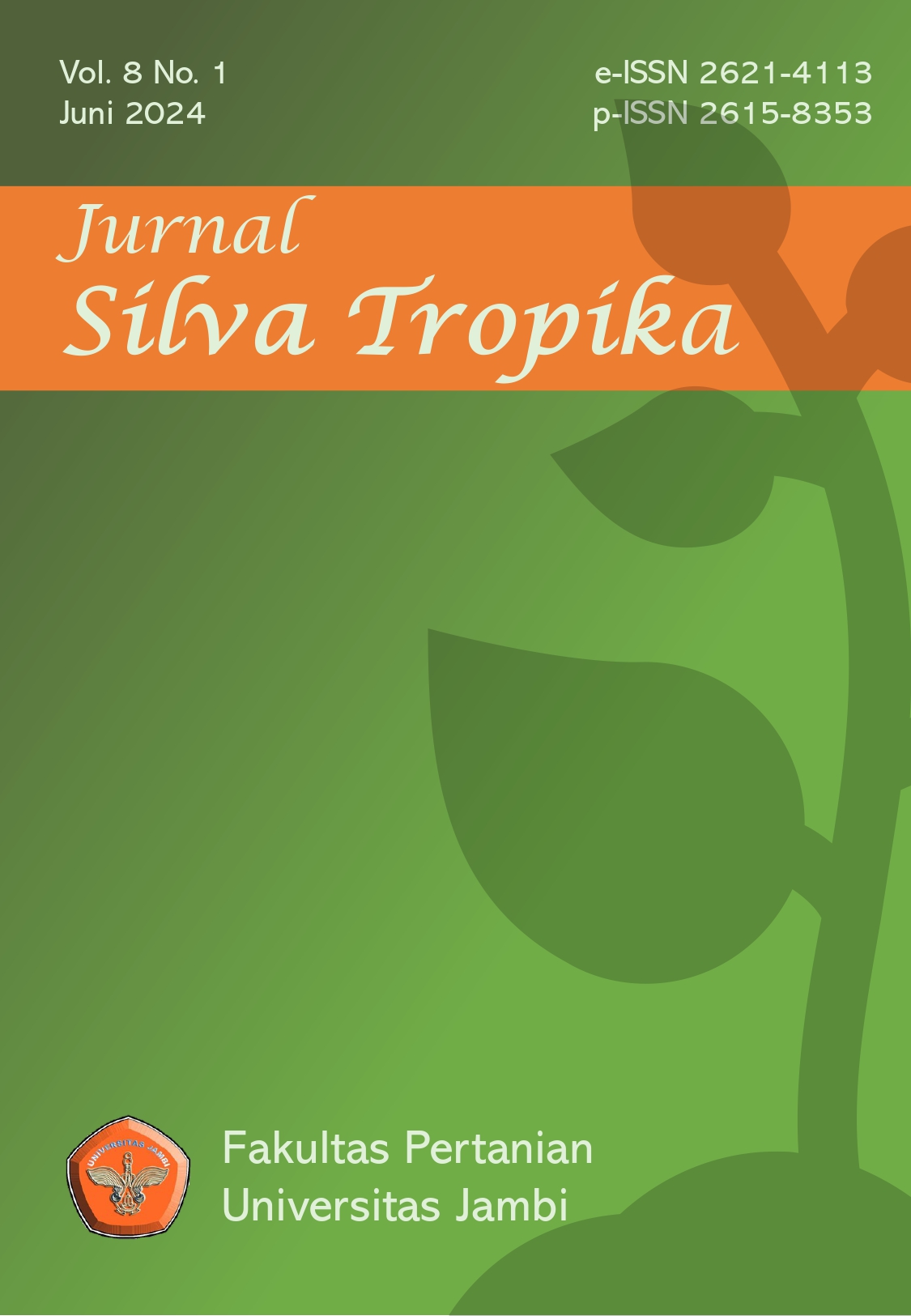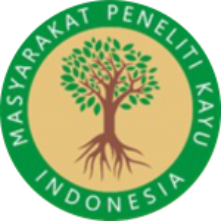Sifat Kimia Kayu Medang Sereh Berdasarkan Bagian Kayu dan Posisi Batang
Chemical Properties of Medang Sereh Wood Based on Wood and Log Position
DOI:
https://doi.org/10.22437/jurnalsilvatropika.v8i1.33812Abstract
ABSTRACT
The other properties of medang sereah (Litsea sp.) wood that need to be identified are the chemical properties of wood based on the part (terrace and sapwood) and the position of the trunk (base, middle, and end). The purpose of identifying the nature of this lemongrass medang wood will facilitate the introduction of lemongrass medang wood types with other types of medang wood. In addition, it will facilitate the process of working and the purpose of using these types of wood further according to their characteristics because the identification of wood properties is an initial process in determining the allocation of wood utilization. The levels of holocellulose, alpha-cellulose, hemicellulose in the core have relatively greater levels than the sapwood. The hemicellulose content at the base has a relatively higher value compared to the end and middle of the medang citronella log. The lignin content of the sapwood part has a lower tendency compared to the terrace. The results of the analysis also showed that the wood at the end of the trunk had a fairly high lignin content compared to the base of the trunk.
Keywords: Litsea sp., wood position, wood chemical, terrace and sapwood
ABSTRAK
Sifat kayu medang sereh lainnya yang perlu diidentifikasi yaitu sifat kimia kayu berdasarkan bagian (teras dan gubal) dan posisi batangnya (pangkal, tengah, dan ujung). Tujuan mengidentifikasi sifat kayu medang sereh ini, maka akan mempermudah dalam pengenalan jenis kayu medang sereh dengan jenis kayu medang lainnya. Selain itu, akan mempermudah proses pengerjaan dan tujuan penggunaan jenis kayu tersebut lebih lanjut sesuai karakteristiknya karena identifikasi sifat kayu merupakan suatu proses awal dalam menentukan alokasi pemanfaatan kayu. Pengujian komponen kimia mengacu pada standar ASTM. Kadar holoselulosa, alpha-selulosa, hemiselulosa bagian teras memiliki kadar relatif lebih besar dibandingkan bagian gubal. Kadar hemiselulosa pada bagian pangkal memiliki nilai yang relatif lebih tinggi daibandingkan bagian ujung dan tengah batang kayu medang sereh. Kadar lignin bagian gubal memiliki kecenderungan lebih rendah dibandingkan dengan bagian teras. Hasil analisis juga menunjukkan bahwa kayu dibagian ujung batang memiliki kadar lignin yang cukup tinggi dibandingkan bagian pangkal batang.
Kata kunci: medang sereh, posisi batang, kimia kayu, bagian teras dan gubal
Downloads
References
Achmadi SS. 1990. Kimia Kayu. Departemen Pendidikan dan Kebudayaan. Direktorat Pendidikan Tinggi Pusat Antar Universitas Ilmu Hayat. IPB. Bogor.
Akiyama K, Matsuzaki Ki dan Hayashi H. 2005. Plant sesquiterpenes induce hyphal branching in arbuscular mycorrhizal fungi. Nature 435, 824–827.
Anggraini R, Agustina A, Komariah RN, Khabibi J. 2023. Identifikasi Makroskopis dan Mikroskopis Kayu Medang Sereh Berdasarkan Bagian Batang. Jurnal Silva Tropika. Vol. 7. No.1. Hal. 20-30.
Anggraini R, Khabibi J. 2021. Karateristik ekstrak gergajian kayu tembesu (Fagraea fragrans), rengas (Gluta renghas) dan Medang (Litsea sp.) sebagai larva lalat rumah (Musca domestica). Jurnal Tengkawang. 12(1):86-93.
Anggraini R, Komariah RN, Agustina A. 2022. Sifat Fisis Kayu Medang Sereh Berdasarkan Posisi Batang dan Bagian Kayu Teras dan Qubal. Jurnal Silva Tropika. Vol. 6. No.1. Hal. 51-59.
Bowyer JL, Shmulsky R and Haygreen JG. 2003. Forest Products and Wood Science: an Introduction. Fourth Edition. Iowa (US): Iowa State University Press.
Browning BL. 1967. Method of Wood Chemistry. Wiley Interscience Publisher. New York.
Bruce J. Zobel, Jerry R. Sprague. 1988. Juvenile Wood in Forest Trees, Book, Springer Berlin, Heidelberg.
Casey JP. 1980. Pulping Chemistry and Chemical Technology Volume 1. Pulping and Paper Making New-York. Intercine Publisher Inc.
Dence CW. 1992. The Determination of Lignin. In; Lin SY, Dence CW (Eds). Method in Lignin Chemistry. Spinger-Verlag. Berlin
Fengel D, Wegener G. 1995. Kayu; Kimia, Ultrastruktur, Reaksi-Reaksi. Terjemahan. Yogyakarta: Gajah Mada University Press.
Khabibi J, Syafii W, Sari RK. 2016. Reducing hazardous heavy metal ions using mangium bark waste. Environ Sci Pollut Res 23, 16631–16640 (2016). https://doi.org/10.1007/s11356-016-6776-0
Lukmandaru G, Fatimah S, Fernandes A. 2015. Sifat kimia dan warna kayu keruing, mersawa dan kapur. Jurnal Penelitian Ekosistem Dipterokarpa, Vol. 1, No. 2. Hal 69-80
Sjostrom E. 1995. Kimia Kayu Dasar-Dasar dan Penggunaan. Terjemahan. Yogyakarta: Gajah Mada University Press.
Stenius P, Gullichsen J, Paulapuro H. (Eds.). 2000. Papermaking Science and Technology, Book 3. Forest Products Chemistry. Fapet Oy.
Swan B. 1965. Isolation of acid soluble lignin from the klason lignin determination. Svensk Papperstidning 68:791-795.
TAPPI T 264 OM-88 (1988) Preparation of wood for chemical analysisi. TAPPI, Norcross, GA.
Downloads
Published
How to Cite
Issue
Section
License
Copyright (c) 2024 Riana Anggraini, Jauhar Khabibi, Suci Ratna Puri

This work is licensed under a Creative Commons Attribution 4.0 International License.








